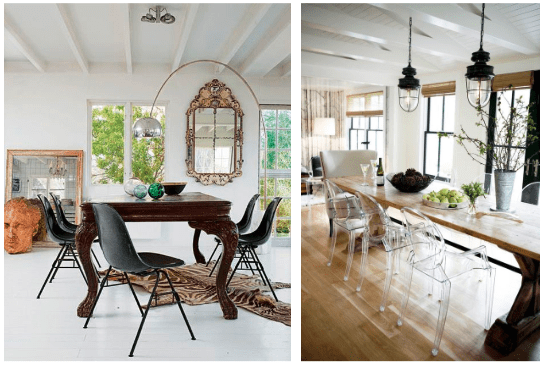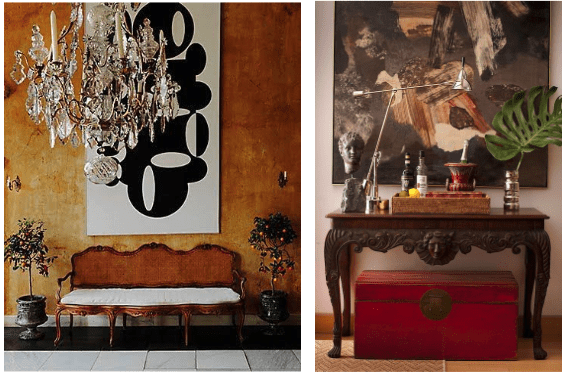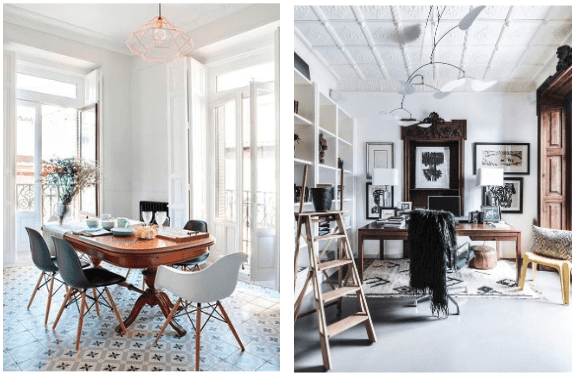Fashion and interior design principles have always overlapped, with one influencing the other. ‘Smart casual’ is a fashion term that has successfully transitioned into the world of interiors, being the inspiration for spaces that are a blend of refined, stylish, elegant, rustic, eclectic and relaxed. Mixing and matching antiques with modern pieces has always been popular, but that is evolving to embrace the collaboration of smart and casual furniture and accessories.
Mixing smart and casual furniture from different design eras is a relatively new decor philosophy, although the French have always been at the pioneering forefront of this look.
When you are brave enough to curate different styles, colours and textures together in one space, the result is always a welcoming ‘lived-in’ feel that celebrates an effortless narrative that is both strikingly smart and casually informal.

The ‘smart casual’ design brief is open to interpretation and the scope of furniture and accessories is vast. Antique furniture can be both, and contemporary pieces also straddle the fence with formal and informal options that speak to all personal decor preferences.
So don’t limit your decor approach by assuming that the smart casual look is only limited to pairing an antique item with a modern piece. It is so much more fluid than that.
The smart casual approach to ‘dressing’ a room
As with fashion, mixing trendier pieces with classic antique staples mitigates an outfit or room looking too formal or that you tried too hard. The goal is a space where the furniture pieces and accessories look pulled together but in an interesting and approachable way. It’s all about playing with design elements.
You have 3 choices:
#1 The top-to-bottom approach is where you start with smart or formal lighting options such as an antique crystal chandelier and then your dining room table, living room chairs, bed or side table choices are casual, relaxed pieces. (This is akin to the timeless look of sneakers and ripped jeans paired with a silk blouse and diamond earrings.).
#2 The bottom-to-top approach is simply the decor inverse. You may have a really formal dining room table, living room chairs or Persian carpet, and then as your eye travels up the room, you add casual hanging lanterns for lighting or fun informal artwork or mirror collages on the wall. (Imagine stilettos and smart trousers with an oversized cotton shirt and denim jacket).

#3 The eclectic-ensemble approach is where the rule book is thrown out the window. This is a daring experimental mix-and-match approach to smart and casual furniture and accessories. Take a smart antique Persian carpet, a really rustic dining room table, in-your-face bold modern chairs, a smart chandelier and a couple of casual bookshelves or a Riempie bench. On their own, the individual pieces wouldn’t seem to sync with each other, but once placed together, a cohesive story emerges and the look just makes sense. (High heels, casual jeans, a T-shirt, a blazer and a crossover bag are your fashion inspiration for this look).
Avoiding a ‘mismatched’ smart casual look
Knowing how far to go and which smart antique, vintage or modern furniture and accessories will best complement casual pieces does take a little skill to create a cohesive aesthetic. There is a fine line between restrained and effortless versus over-the-top and chaotic.
Making an overall room work often comes down to colours and textures that you pull throughout the room.
#1 Choose a common, repetitive thread. This could be a furniture style – such as French or mid-century vintage – or a colour, pattern or texture that weaves through the room to anchor the look and make sense. Once that starting point is decided on, building up the layers by adding a few smart or casual furniture or accessories as a counterbalance will do the trick. (This works particularly well in monochromatic schemes).

#2 Let the colour wheel guide you. If you love a little colour personality, then a neutral base shade with two complementary colours always works. (You can also use different hues of a specific colour to up the ante for additional design interest). Using a darker palette in your furniture with lighter accessories and walls – or vice versa – will be a successful decor dialogue.
#3 Less is more (in principle not necessarily pieces). The principle of ‘less is more’ will be the restraint to make sure that you cleverly curate the collection of pieces that make it into any space of your home and don’t mix and match too many different types of antiques, colours, styles or eras in one space. You can always slowly build up a look, but overdone is overwhelming and the goal is to avoid visual noise and clutter. Your eyes need to have the opportunity to rest and enjoy well-placed and carefully chosen smart and casual furniture and accessories in a room.
Spaces that are warm, comfortable and inviting, but that also boast a sophisticated designer edge start with the flair of mixing smart and casual furniture and accessories. Even if you only collect antiques, are a fan of exclusively mid-century modern furniture or are only in love with modern pieces, the interior design philosophy will speak your unique decor language.


 Whatsapp us now
Whatsapp us now